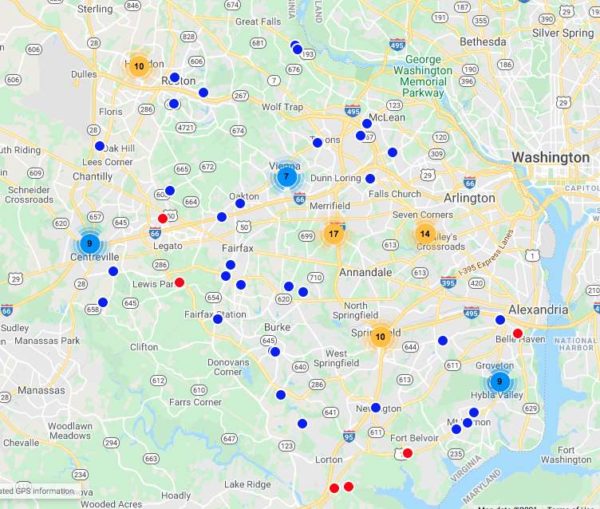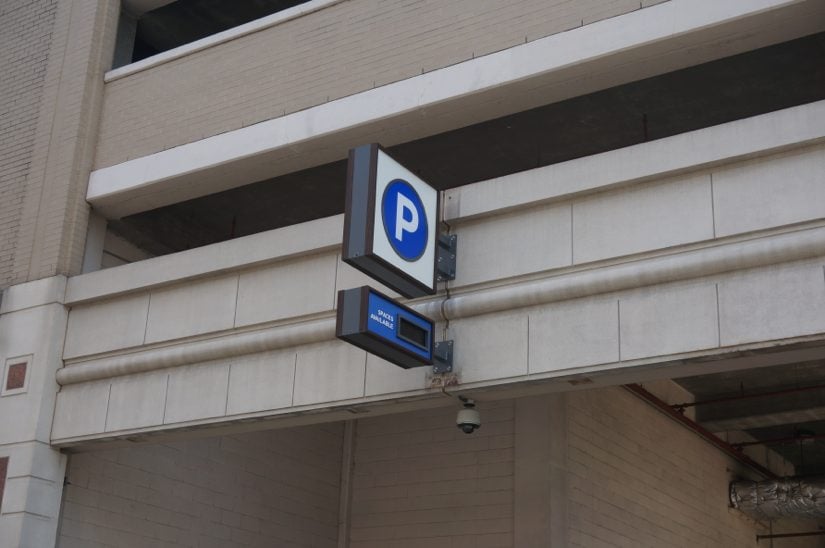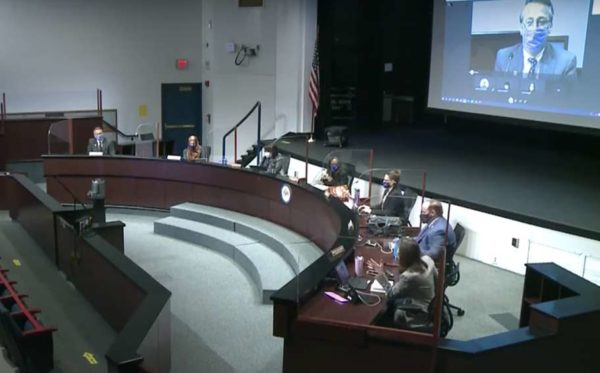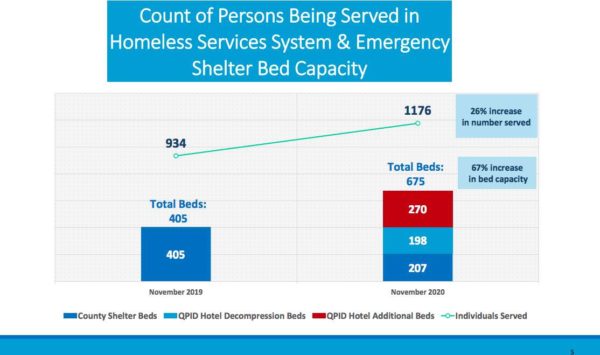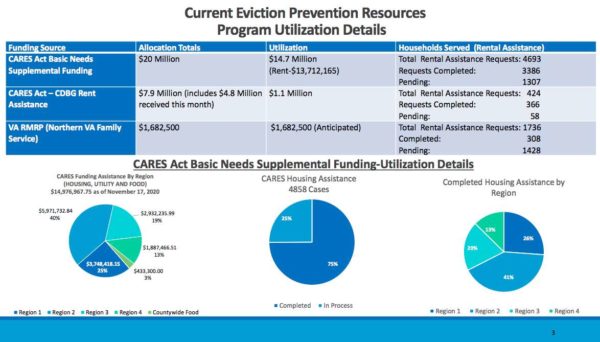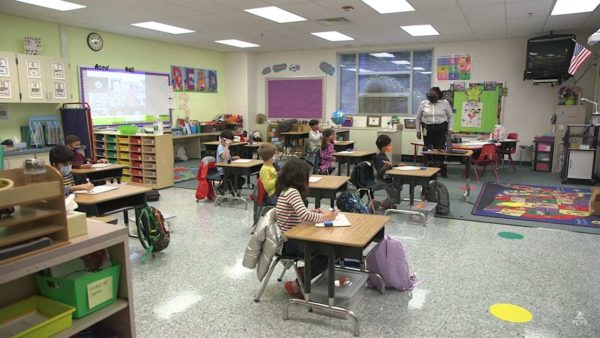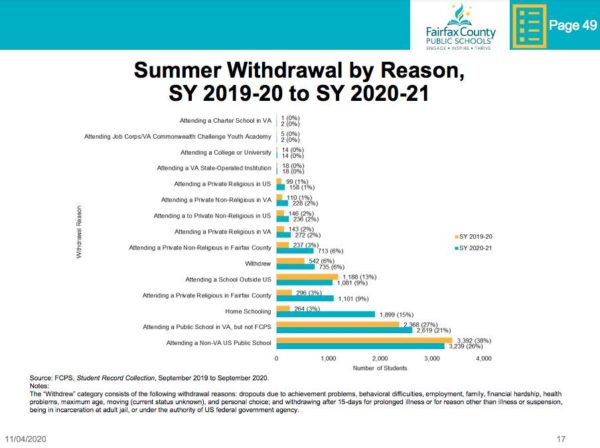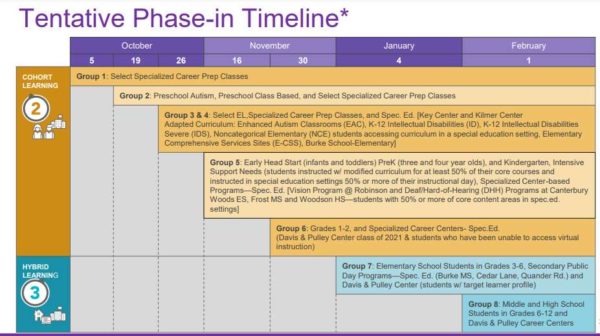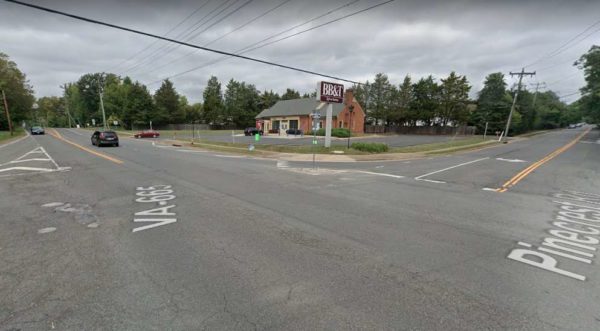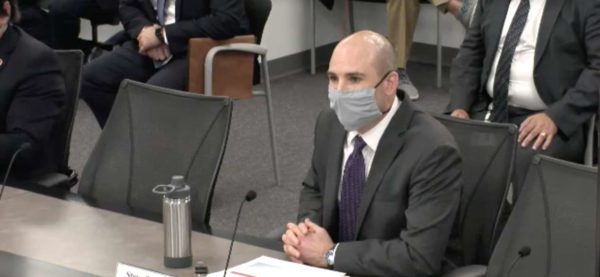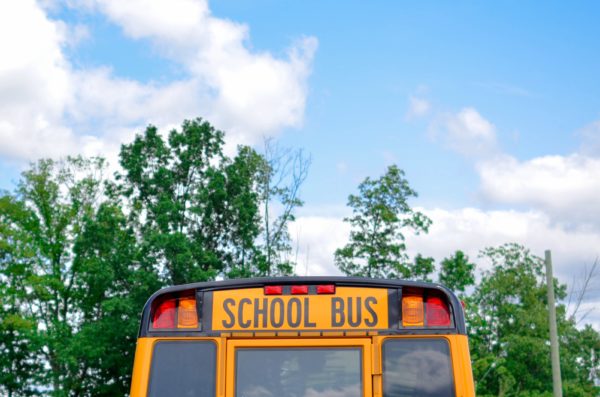Updated at 11:45 — The fatality and crash numbers in this article from the DMV reflect statistics for Northern Virginia, not just Fairfax County as previously stated. The Fairfax County Police Department says that the county’s fatality and crash rates are much lower.
With 38 pedestrian fatalities, 2019 was the deadliest year in the last decade to walk in Northern Virginia, according to Virginia DMV data.
The number of deaths dropped to 29 in 2020, but the Fairfax County Board of Supervisors and county transportation officials are still working on strategies to improve pedestrian and bicyclist safety with a countywide initiative.
“Unfortunately our incidents of pedestrian fatalities and crashes continue to be at unacceptable levels,” FCDOT bicycle and pedestrian program manager Chris Wells said during a transportation committee meeting yesterday (Tuesday). “Due to a number of factors, those numbers are trending up — not just in Fairfax, but in Virginia and across the United States.”
Bicycling is safer, but crash rates are still high: 216 crashes in 2019, and 157 in 2020.
Wells added that certain portions of Fairfax County’s population are disproportionately affected by pedestrian crashes, a trend that has been documented nationwide.
The county hopes to reverse these statistics. Wells told supervisors that FCDOT and VDOT have recently improved walking and cycling conditions by programming head starts into signals for pedestrians, re-striping four-lane roads as two-lane roads, and installing rapid-flashing beacons for crosswalks without lights.
VDOT awarded FCDOT $1.2 million last year to install nine more flashing beacons, bringing the county’s total to 17, Wells said.
VDOT also has a pedestrian safety action plan for improving safety along particularly dangerous corridors. In Fairfax County, the highest-priority roads are Columbia Pike, Little River Turnpike, Richmond Highway, Lee Highway, Lee-Jackson Memorial Highway, Braddock Road, and Ox Road.
Officials said that work on roads in Fairfax County is a lengthy process compared to other jurisdictions, because VDOT owns the roads.
“They’ve really stepped up this year to help us to advance pedestrian safety in a way that we have not seen in years past,” FCDOT Director Tom Biesiadny said.
Looking ahead, supervisors suggested introducing better lighting and longer crossing times at mid-block crosswalks. They are also still interested in reducing speeds in the county.
FCDOT officials said a multiagency group, including transportation officials and attorneys, is working through the logistics of speed cameras. Meanwhile, VDOT is preparing to examine where speed limits can be lowered.
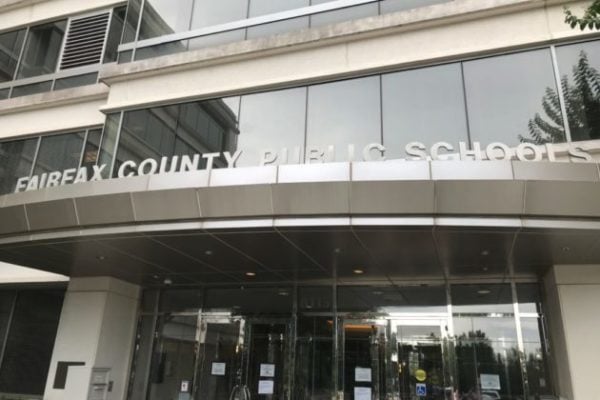
Fairfax County Public Schools Superintendent Scott Brabrand is asking for a $3.1 billion budget for the 2022 fiscal year that focuses “on the most pressing needs” of the school system.
He presented the nearly level-services budget — “a modest request” with an approximately $400,000 increase — to the county school board last Thursday (Jan. 7).
The proposed budget requests a $42.7 million increase in transfer funds from the county government to pay for new preschool special education classes, retirement rate increases, and rising health care costs, which would patch over a gap created by drops in county and state revenue due to the COVID-19 pandemic.
“As all of you know, the COVID-19 pandemic has impacted FCPS, our students, families, and staff in ways we couldn’t have imagined,” Brabrand said during the meeting. “I have designed a budget to meet the educational and social-emotional needs of our children so they can continue to learn and grow despite the challenges of the past year.”
The proposed budget includes money for distance learning, including cybersecurity protection and Zoom, which will replace Blackboard for web-conferencing, he said.
The budget does not contain compensation increases for most employees, though there is $3 million to finish a three-year initiative to increase the salaries of instructional assistants and public health training assistants.
In December, Virginia Gov. Ralph Northam outlined a state budget for schools that features a one-time, 2% bonus for teachers and support staff, with the potential for the salary boost to become permanent. But Brabrand said Fairfax County is opting out because it cannot afford to participate.
The burden would be on Fairfax County to match state funds with $32 million in county-level funding, he said.
“We understand that [FCPS] kept everybody whole,” Fairfax Education Association President Kimberly Adams said. “But many staff see it as a slap in their face.”
In comparison, Prince William County offered compensation increases in its budget last year , and Loudoun County’s proposed budget for the upcoming fiscal year includes money to cover compensations that were frozen last year, she said.
“If Loudoun and Prince William moved two steps ahead of Fairfax, we’re behind,” she said. “People are already irritated. This is a potential reason to leave.”
The lack of compensation particularly hurts Virginia teachers, who have the largest teacher wage penalty in the country at 32.7%, Fairfax County Federation of Teachers President Tina Williams said.
“We’re disappointed that the FCPS proposed budget does not include a pay increase for school employees, especially after a year that is the hardest in their career,” she said in a statement. “We urge FCPS to demonstrate it values the hard work and dedication of its employees by providing wage and cost of living adjustments to help keep employees whole.”
The Fairfax County School Board will hold a work session to discuss the proposed budget tomorrow (Tuesday). A public hearing has been scheduled for 6 p.m. on Jan. 26, though it could carry over to Jan. 27 if needed.
The school board will adopt its advertised budget on Feb. 18 and present it to the Board of Supervisors on April 13. A final approved budget is scheduled to be adopted on May 20.
The Fairfax County Board of Supervisors gave the county’s transportation department permission this week to start work on plans for managed curbside parking in Tysons and Reston.
Whether the plan includes paid parking, time-limited parking, designated commercial vehicle parking, or some combination, the Fairfax County Department of Transportation will need at least a year to draw one up for the Board of Supervisors to review, staff said during a board transportation committee meeting on Tuesday.
The incremental step forward comes after professional traffic engineers released their findings from a two-year study that analyzed current parking habits in Tysons’ urban center and Reston’s transit station areas as well as potential options to manage parking.
“Currently in the county, we have a very limited toolbox of parking restrictions that can be implemented by either the Board or VDOT,” FCDOT Section Chief Neil Freschman said. “Generally, most on-street parking on public roadways is uncontrolled.”
The study found that public on-street parking in Reston is incredibly limited.
Parking is available on just 6% of the 15 miles of public curb space surrounding the Wiehle-Reston East, Reston Town Center, and Herndon Metrorail stations, FCDOT Senior Transportation Planner Henri Stein McCartney said.
“We found 211 total public on-street spaces within the study area, which is pretty low,” she said. “Most parking is on private streets, which we don’t manage.”
Comparatively, Tysons had more parking. Staff found 1,272 spaces along 22 miles — or 29% — of curb space on the roadways surrounding the Greensboro, Springhill, Tysons, and McLean Metro stations.
However, parking in Tysons suffers from other problems, including cars parked in “No Parking” zones and travel lanes, along with large commercial vehicles that overstay their welcome.
“Some of these vehicles are reportedly parking for days or weeks without moving,” McCartney said. “Our parking staff has received multiple complaints from Tysons businesses about commercial vehicles that are parking long-term near their building, so we know this is an issue.”
Transportation Committee Vice-Chair Kathy Smith, who represents Sully District, told Tysons Reporter that commercial vehicles parking for extended periods is a county-wide issue.
“I think it’s good that staff is looking into how to balance people’s ability to get into businesses and getting more turnover,” Smith said. “Everybody would agree you don’t want commercial vehicles taking up space for days.”
This parking plan is being developed alongside changes to the street grid in Tysons and Reston, Hunter Mill District Supervisor Walter Alcorn told Tysons Reporter. In some cases, parking policies will be developed for streets that do not yet exist, but have been incorporated into the two communities’ comprehensive plans to be more transit-oriented.
The management plan should encourage parking spot turnover to ensure that these future streets near transit stations, which are lined with mixed-use properties, do not become commuter lots, he said.
However, managed parking in Reston’s transit areas will have to overcome the controversy that Boston Properties ignited when the property manager introduced and later modified paid parking at the Reston Town Center.
“The number one lesson is, don’t make all your streets private,” Alcorn said. “We have an awful lot of private streets. What we’ve learned is that the public doesn’t have any say — it is up to the private street owner.”
While private streets make planning events more flexible, Alcorn says the 2017 flare-up, which focused mostly on the garage parking, could also be attributed in part to community members not having a say.
For the most part, though, what FCDOT is working on “is apples and oranges” compared to the RTC, he said.
Image via Fairfax County
Fairfax County Public School administrators are looking to write a new policy that will ban secluding children across the division by 2023.
The new policy governing when and how children can be restrained or secluded would also require administrators to contact parents the day of an incident and to review data every quarter. After being restrained or put in a room alone, students would meet with a trusted staff member who could provide positive supports.
“We are delighted that FCPS recognizes that they were in shocking non-compliance with federal regulations,” Fairfax County Special Education Parent-Teacher Association President Michelle Cades told Tysons Reporter. “We are really optimistic that reporting is going to improve and that there is going to be more transparency.”
According to the policy, starting in 2021, seclusion will only be allowed at Burke School and Key and Kilmer Centers.
“We’re requesting that it be prohibited in 99% of schools now, but 100% is our desire, 100% is our goal,” Assistant Superintendent of the Special Services Department Michelle Boyd said in a work session last week.
The policy would go into effect Jan. 1, 2021, and includes some clauses that respond to feedback from parents and other stakeholders. FCPS will hold a public hearing on the new policy on Friday.
These changes come one year after a 2019 WAMU investigation found hundreds of instances of restraint and seclusion in FCPS, even though the school division had not reported a single incident to the U.S. Office of Civil Rights for 10 years.
“We have to make sure that people feel confident, not just in the new policy, but that we are implementing the data collection with fidelity,” Superintendent Scott Brabrand said during a Dec. 1 work session. “We have to acknowledge that for too many years, we reported no information, as did other school districts, and it was wrong.”
At-Large School Board Representative Abrar Omeish questioned what data FCPS is relying on to be confident that a new restraint and seclusion policy will be implemented properly.
“I worry about relying on this information, when we have reason to believe that it is not reliable,” she said. “We should imagine the worst-case scenario and put in place the checks that are going to hold us accountable to make sure we’re not wronging kids in the process.”
The school board and community members both raised concerns about an initial draft of the policy that was released prior to the Dec. 1 work session. That version gave a window for notifying parents of two school days, did not prohibit supine restraints (where the child is lying face-up on the ground), and had no explicit mention of eventually banning seclusion at all schools.
SEPTA criticized the initial proposal as failing to meet state regulations and best practices, saying that it “appears to discriminate against students with disabilities.”
“Given [the county’s] history, the public and the special education community of Fairfax County do not have faith that FCPS will act with integrity and transparency in any use of restraint or seclusion,” SEPTA said in a statement.
School board members argued that same-day notification in particular should be a priority.
“I can’t find that it is tenable that this school system is capable of notifying parents when there is a discipline issue or a health issue, but we’re not going to notify if their child has been restrained or secluded,” Braddock District School Board Member McLaughlin said.
The most recent draft of the proposed policy was released on Dec. 4 and incorporates some of the school board’s requested changes, including the same-day notification requirement and a ban on supine and prone restraints.
“They went back and, it looks like, put a lot more thought and consideration into how the regulations will be implemented here in Fairfax,” Cades said. “[Supine and prone restraints], where you have multiple people forcibly holding a child down on the floor, are more dangerous. You have a much greater likelihood of injury or death.”
Omeish said during the school board’s Dec. 3 meeting that she will likely be bringing a motion to “ban seclusion and to replace the rooms with sensory rooms.”
SEPTA is encouraging the community to register to speak at the public hearing. The group is facilitating anonymous participation ahead of the public meeting, where volunteers could read testimonies from parents.
Photo via FCPS
About 250 more people are using Fairfax County’s emergency homelessness services this November over last November, and there are enough beds for just over half of them.
That number could increase as the federal ban on evictions draws nearer.
“As we look at potential rising eviction numbers, we need to be aware of the capacity for the homelessness system,” Fairfax County Health, Housing and Human Services Chief Strategist Dean Klein told the Board of Supervisors during a Health and Human Services committee meeting on Tuesday (Nov. 24).
With COVID-19 cases rising, Fairfax County is dealing with increasing numbers of people experiencing homelessness as well as the threat of rising eviction rates. Klein says rent assistance and partnerships with landlords will be critical for preventing evictions and keeping people in homes this winter.
“Our ongoing efforts to reach out to vulnerable populations is increasingly critical,” he said.
One step Fairfax County has taken is to form an eviction prevention task force with representatives from various county agencies, the county sheriff’s office, and the nonprofit law firm Legal Services of Northern Virginia.
Klein says he hopes to receive financial support from the Board of Supervisors next month. His staff anticipates spending at the same level as it is right now, which is about $600,000 a week.
Providence District Supervisor Dalia Palchik said a board matter is in the works that would “give additional local support for our continuation of basic needs, which we know continues to be a concern for us.”
Although funding comes from a number of sources, some are set to run dry soon, adding to the sense of urgency.
The Federal Emergency Management Agency stepped in this year to pay for hotel rooms so that people experiencing homelessness could have a place to sleep safely during the pandemic. However, it is unclear how long FEMA will continue to provide funding, Klein says.
Fairfax County Office to Prevent and End Homelessness Deputy Director Tom Barnett said the FEMA commitments are on a month-to-month basis and will last through the middle of December.
“We will continue to request extensions every month as they will support most of these expenses,” he said.
The U.S. Department of Housing and Urban Development has committed emergency-solutions grant funding to support shelter and rehousing efforts, but those funds “would be quickly used up if FEMA does not continue their support,” Barnett said.
Fairfax County also received more than $30 million in federal and state CARES Act funding and community development block grants to cover basic needs, including rent and mortgage assistance, on top of the $5 million that the county contributed.
“Not only do we need strategies and assistance to move through the end of the year, but we absolutely know this is not ending in 2020,” Palchik said. “Hopefully we will have more state and federal support to address the needs of our community.”
While some social support efforts tackle the challenge of sheltering people during the pandemic, others focus on preventing residents from ending up on the street in the first place.
In August, Klein’s office assigned social workers to 900 people in the legal system who are at-risk for evictions. So far, social workers have helped 300 people. Klein says the likely reason why so many did not respond is that the only way to reach this group of people was by mail.
The office is also beginning outreach to landlords, who might not receive rent payments from third parties. A $150,000 grant from the Kaiser Foundation has gone toward hiring people to work with landlords, but more outreach is needed, Klein says.
On the tenant side, Klein said his office developed guides that explain the current eviction moratorium and help tenants contact the organizations that provide rent payment assistance.
“With the numerous moratoriums, you can imagine how confusing it can be,” Klein said.
Dipti Pidikiti-Smith, the director of advocacy at Legal Services of Northern Virginia, says a number of new provisions protect tenants from being evicted.
Landlords cannot evict tenants unless they provide documentation of what they’re owed and information on available rental assistance programs. Landlords who own five or more units, or have at least 10% interest in five or more units, must offer a payment plan without late fees. Tenants cannot be evicted unless they refuse the plan.
These provisions remain in place through Dec. 31 and will be replaced by similar ones in January, Pidikiti-Smith said.
The Fairfax County Board of Supervisors indicated interest in a pilot program for electric-powered buses during its transportation committee meeting on Tuesday (Nov. 10).
During the meeting, Fairfax County Department of Transportation Director Tom Biesiadny delivered an presentation that explained the “ins and outs” of electric vehicles and and included a proposal for moving forward with a pilot plan.
The next step would be to return to the supervisors with a more in-depth financial plan that includes details such as when and where this would take place, and how long the demonstration would last, which could be in the early part of 2021, Biesiadny says.
“This is exciting,”said Board of Supervisors Chairman Jeffrey McKay. “Clearly we need to jump into this area and we need to do it quickly.”
Providence Supervisor Dalia Palchick supported a pilot because it would help ensure the county implements these changes correctly.
“This is the future,” she said. “We need to stop going backward. I’m hopeful to see a plan not just to see a pilot but do a demonstration project, which in my mind, means ‘how can we move forward?'”
A pilot with four buses could cost between $3.8 million and $4.2 million, a gross cost that does not take into account sources of funding. Some money has been set aside through a bus replacement program, and there are grants available, Biesiadny said.
FCDOT has in-house and external expertise from Fairfax’s “ongoing partnership with Dominion Energy” and the Richmond Highway Bus Rapid Transit team to draw from, said Tom Reynolds, the FCDOT Section Chief of Transit Services Division.
The pilot would help the department learn about the buses’ range and charging, how they perform during different seasons of the year and on various local and express routes, and what staff training needs to be done, Reynolds said.
“The sooner we do the pilot, the sooner we see the results of it, the sooner we can start to make longer-term decisions about some of the capital costs that would be necessary if we were to expand this,” McKay said.
When the county talks about costs, Palchik — who said she developed childhood asthma living in the area — and Braddock Supervisor James Walkinshaw emphasized the costs of treating asthma and the health impacts of poor air quality.
“In Virginia, we spend $87 million a year because of asthma hospitalization,” Walkinshaw said. “Fairfax County is lower, but Route One is higher. Annandale is higher. Other parts of the county are higher. It would be a small thing, but as we look at this pilot, we might want to look at locating it in parts of the county that have been hit harder by asthma.”
Fairfax County’s first effort to introduce electric vehicles into public transit came this year with the autonomous Relay shuttle now operating in the Mosaic District. That demonstration project is a partnership with Dominion Energy, Biesiadny said.
Photo via Electrify America
Driven by the uncertainty created by the COVID-19 pandemic, 8,959 students left Fairfax County Public Schools this school year with elementary school students, particularly kindergarteners, representing the most withdrawals.
About 87% of the students who left are in elementary school, and of those, 2,208 students would be kindergarteners, according to a Membership Trends Report presented to FCPS School Board members last Wednesday (Nov. 4). This report is used to inform the school board’s capital improvements planning process.
Transfer rates to other public schools in Virginia and the U.S. are on par with previous years, but FCPS has seen new spikes in students who transferred to private schools in Fairfax County or who switched to homeschooling.
“Right now, this is an unprecedented time, and it is reflected in the data we have,” Jeffrey Platenberg, the FCPS assistant superintendent of facilities and transportation services, said. “We have a lot going on and we don’t know how to proceed forward until we get this pandemic under control. To do anything during this time might not be recommended by the wisest of folks, because the data reflects such a marked difference from last year.”
If the dip in enrollment is temporary, FCPS will see a bubble in kindergarten next year that will roll through Fairfax County for the next 12 years, according to Superintendent Scott Brabrand.
“You have to do some things differently in our facilities for the next decade,” he said.
School board members and FCPS staff are already bracing for kindergarten enrollment to surge both when FCPS welcomes them back to school on Nov. 16 and for the next academic year starting in the fall of 2021.
That influx is a source of concern for school principals, Springfield District School Board member Laura Cohen says.
“Short-term and long-term kindergarten problems, how are we going to solve this?” Cohen asked.
Brabrand said FCPS is “overstaffed in kindergarten” because it acquired staff in the spring, when attendance had not yet taken a hit, rather than in late summer, when the hiring pool is much smaller.
“I know people don’t want to hear the ‘t-word’ of trailers, but we’re going to have some space challenges at those schools,” he said.
The remaining membership decreases were more modest, with 217 middle school students, 392 high school students, 356 center and alternative program students, and 165 students in other programs.
Yearly, FCPS sees thousands of students leave for public schools in other states, but the number of students who instead chose to homeschool or attend a private religious or secular school in the county this year is out of the ordinary.
Nearly 1,900 left to be homeschooled this year, up from 264 last year. About 1,100 left for a private religious school in Fairfax County, and 713 for a non-religious private school, up from 296 and 237 last year, respectively.
“When you look at those who have chosen [private schools], there is a significant increase over the prior year,” Platenberg said. “That’s pretty informing why families chose to withdraw from FCPS.”
Of the five FCPS regions, the largest withdrawal rates come from Region One, which has schools in Herndon, Reston, Vienna, and the Langley area of McLean, and Region Three, which encompasses the area south of the city of Alexandria.
“I’m concerned when I look at some of these numbers at our high school level,” At-Large School Board Member Rachna Sizmore Heizer said.
She said schools with high rates of students who qualify for free- and reduced-price meals are seeing higher enrollment drops from last year to this year. She asked staff whether these changes are due to students not logging in and dropping out.
“We really are tracking that very carefully,” Deputy Superintendent Francis Ivey said.
This is not the first time schools with higher levels of families below federal poverty lines have been impacted by current events, Platenberg said.
“We’ve seen those trends with economic changes and changes in administrations, lags and shifts that occur,” he said.
Photo via FCPS
With Covid-19 cases rising and cold and flu season on the horizon, schools must focus on common-sense cleaning and disinfecting practices if they want a safe return, the American Cleaning Institute says.
On Nov. 16, Fairfax County Public Schools will open in-person instruction for Early Head Start, pre-kindergarten, kindergarten, and special-education students receiving intensive supports and attending center-based programs, according to an update sent to parents on Oct. 23. In-person cohort learning will begin on Nov. 30 for grades 1-2 and special-education students in career centers.
In partnership with the U.S. Centers for Disease Control and Prevention, the ACI is asking schools and families to encourage children to wash their hands with soap at school and at home. Hand hygiene is a foundational habit for slowing the spread of the novel coronavirus and seasonal illnesses like influenza, especially in schools.
“It’s so simple and so important, especially at schools, as they plan to reopen,” said Brian Sansoni, the Senior Vice President of Communication, Outreach and Membership at the American Cleaning Institute.
But among adults in the United States, hand-washing rates are down compared to the start of the pandemic, according to a recent survey by the ACI. Parents play as big a role as schools in forming hand hygiene habits, Sansoni said.
“Kids see what parents do and don’t do,” he said. “Reinforcing habits at home is really important for setting examples.”
Schools must be extra diligent in communicating to parents the importance of hand-washing habits at home. Schools must also be hyper-vigilant in restocking soap and hand-sanitizer dispensers, and providing supervision and encouraging hand-washing before eating and after restroom use.
“Where the extra care is required, hopefully there is communication between parents and school staff,” Sansoni said.
Another common-sense practice is disinfecting high-touch hot-spots daily. These zones include desks, chairs, tables, countertops, knobs, light-switches, classroom electronics, toilets, and drinking fountains.
Coincidentally, the COVID-19 pandemic hit as the ACI was planning to revamp its Healthy Schools, Healthy Peopleinitiative, Sansoni said. This year, the institute was preparing to focus more on hand hygiene and cleaning as a way of reducing absenteeism caused by seasonal illnesses.
“Once we get past this, hopefully, we don’t take our foot off the pedal when it comes to common-sense hygiene,” Sansoni said. “The cold and flu happen every year, and there are countless school days lost due to infection among students and staff.”
Pre-pandemic, the ACI spoke with school nurses across the nation and learned that nurses, at the front lines of school health, face an uphill battle with hygiene education.
Some nurses were frustrated at the lack of soap and cleaning materials, Sansoni said. In other areas, nurses needed their school districts and systems to encourage everyone to exemplify good behaviors.
“They have a tough job,” Sansoni said. “They try to emphasize this year round.”
Photo via the CDC
The Fairfax Education Association is petitioning Fairfax County Public Schools to remain virtual until August 2021.
“Science and Health Safety data support and require that no one should return to in person instruction until there is a widely available scientifically proven vaccine or highly effective treatment,” the petition said. “The metric for Safe Reopening should be 14 days of zero community spread.”
So far, the petition has more than 1,000 signatures and is 600 away from its goal. The union, which represents 4,000 staff in the school system, published the petition on Sept. 30, but received renewed attention after a tweet about it went viral.
The Fairfax County teacher’s union wants all public schools closed at least until August 2021. @FCPSSupt pic.twitter.com/CuLCXRCGOV
— Rory Cooper (@rorycooper) October 20, 2020
But not all teachers support the petition, according to one Twitter user.
https://twitter.com/livinindc8/status/1318613492522430464
Parents who have been vocal on social media in their demands to reopen FCPS denounced the petition and its motivations.
Thank you for sharing this. The teacher's union is absolutely ridiculous! They are also actively trying to portray parents who are concerned for their kids education as "Trump Supporters" and "Republicans". They are terribly simple minded and engaging in stereotyping. @FCFTcares
— Momma Bear (grrrr, rawr, grunt) (@BettyBa62091585) October 20, 2020
FEA was not immediately available to answer questions.
FCPS Spokesperson Lucy Caldwell responded to the petition from the teachers’ union in a statement Wednesday:
Dr. Brabrand is working with FCPS staff and partners to ensure a safe, measured student in-person return to our classrooms and buildings. We firmly believe that while virtual environments are necessary at the current time, students learn best in-person. That experience cannot fully be duplicated on a screen. Many thousands of FCPS teachers, families, businesses, and the community at large, have expressed their strong support for students to return to in-person learning and we are working diligently to make this a reality as swiftly and safely as possible.
Our superintendent will continue to collaborate and engage with teacher organizations as he has been doing for the entirety of the pandemic planning, to help ensure safe, effective plans.
During a work session last Thursday, the Fairfax County School Board agreed to send to school on Nov. 16 students in the Early Head Start program, three- and four-year-olds, kindergarteners and special-education students who spend more than half their time in specialized education settings. No later than Nov. 30, students in grades 1 and 2 and in the specialized career centers will return to school.
The board asked Brabrand to determine the best timeline for regular-education students in grades 3-6 and 6-12, who comprise groups 7 and 8, respectively.
“I advocated for beginning, as soon as possible, some social distanced, outdoor activities for cohorts of students in groups 7 and 8. I am hearing from so many families and students themselves how badly this is needed,” school board member Elaine Tholen said in her weekly newsletter.
FEA outlined five guidelines its members say the school system should follow if it attempts to bring high-needs students and families back to school. According to the petition, they are:
1. All buildings should be equipped with HVAC Merv-13 filters, changed on schedule.
2. All staff should be provided Medical Grade PPE (N95 masks, goggles, face shields, gowns, gloves, foot coverings, laundry service at each site).
3. All staff should be provided COVID testing.
4. NO Employees who feel unsafe, whether Tier 1- Tier 4, should be forced to return before the safe reopening metric of 14 days is met.
5. All staff and families should be granted the option of teleworking/distance learning.
“Since none of the requirements for safe return are likely to be met in the foreseeable future of the 2020-21 school year, we reiterate: Keep Fairfax County Public Schools Virtual for the 2020-21 school year,” the petition said.
The other teachers’ union representing educators in Fairfax schools, Fairfax County Federation of Teachers, recently released data showing that teachers are not confident in the system’s reopening plan.
This came after board members had blasted a previous version of the plan for lacking specific data. Last week’s presentation included metrics on ventilation, personal protective equipment as well as guidelines for making local decisions to open or close school buildings.
Image via Fairfax Education Association
An overwhelming majority of Fairfax County Public Schools teachers say they are not confident in the district’s reopening plan, according to a survey conducted by the Fairfax County Federation of Teachers.
The federation released the results of three surveys Tuesday evening during a press conference. The data paint a stark picture for county teachers, who report fearing for their health and that of family members, working far beyond their contracted hours, and feeling the effects on their mental and physical health.
The message from the Federation of Teachers is clear: Members want the school district to delay reopening until the district plan improves communication, provides specific metrics, and offers every teacher a virtual option, a few hallmarks of the teachers’ 11 requirements for a safe reopening.
“Our position has always been, and continues to be, that we want kids back in school as quickly as possible, but that means as safely as possible,” said Tina Williams, president, Fairfax County Federation of Teachers.
The district did not return Tysons Reporter’s request for comment.
The response comes one week after Fairfax County Public Schools Superintendent Scott Brabrand presented his reopening plan to the county school board. Under the proposed plan, about 6,700 students could return to school in October, with more trickling in throughout the year if conditions improve. Members criticized the lack of hard numbers and concrete metrics, especially regarding school closures after outbreaks.
Of the 1,300 teachers who responded, 85.7% are not confident in the district’s reopening plan, and 70% feel unsafe returning, while 21% said they are “unsure.” About 27% said they would consider taking a leave of absence, while 26% were undecided.
Some teachers who are older or have conditions that make them more vulnerable to the virus, or who live with family members who are high-risk, said they face an ultimatum to work or leave because their applications for accommodations were denied.
Instructional assistant Tia Williams, who said her application was denied due to staffing shortages, is expected to return this October. She is worried about the coronavirus because four cousins and six uncles have died from it.
Diabetes and asthma run in the family, and she has both conditions, making her at-risk.
“I want to continue to work, but I don’t want to bring home a virus to my family,” she said.
Emily VanDerhoff, the vice-president of the teachers’ federation, said the federation does not know how many requests were denied.
“That’s a good question for FCPS. They should be transparent,” she said. “I think they talk like they are all being approved, but they’re not.”
The district did not respond to a request for numbers of approved and denied applications for accommodations.
Audrey O’Hara, who teaches English as a Second Language classes, said her options are to resign, retire, take a leave of absence or consent to enter a building with inadequate ventilation.
“FCPS is asking me to make life-changing decisions where my family loses either way,” she said.
Federation leadership stressed the workload teachers are bearing. Of the 895 teachers who responded, 99% said they worked beyond their contracted hours, including 203 who reported working an extra 20 hours a week.
More than 80% reported that the extra work hurts their sleep, keeps them from exercising and impacts their mental health.
About 60% of teachers said they needed more time, suggesting fewer meetings, shorter instructional days, and more hours for planning.
Photo courtesy Dan Dennis on Unsplash
Some residents of Herndon say they risk their lives — or at least their cars — when they cross the intersection of Fox Mill and Pinecrest roads. Many report going minutes out of the way to avoid turning onto or off of the highway.
But those days of accidents and long waits in the left-turn lane may soon be over.
Next week, the Fairfax County Board of Supervisors will vote on a resolution to authorize a partnership between the county and state departments of transportation to install a light signal and construct left-turn lanes in the intersection, which has been the site of dozens of accidents in five years.
The meeting starts at noon on Tuesday, and can be watched online.
The signal was deemed necessary after the Virginia Department of Transportation studied the intersection. To get started, VDOT will need to conduct a preliminary engineering phase for this project, which will cost $900,000.
This money comes from a county and regional construction reserve fund.
Preliminary engineering for the project began in the fall, according to VDOT.
The county may be responsible for the remaining $4.8 million to pay for the right-of-way and construction phases of this project, but the state and county will look for additional sources of funding and find ways to share costs, the resolution says.
Before work on the signal could start, the transportation department did make improvements aimed at calming traffic. The road lines were repainted to add a left turn lane, which took aim at a frequent maneuver in which drivers going straight illegally moved around the cars that had to wait in a through road to turn left.
Additionally, stop and yield signs were installed and foliage was removed to improve sight distance.
This signal would answer the demands of Herndon residents. The intersection is home to a swim and tennis club, a popular bank and a church, and families must navigate it to get children to and from nearby schools.
In fact, three years ago, more than 560 people signed a petition to demand a solution for the intersection. The Fox Mill Estates Homeowners Association, a nearby community, continues to support the project.
The Commonwealth’s Attorney Steve Descano said his overworked, understaffed office is in a state of crisis, which could have deep ramifications for public safety.
“Potentially innocent people could be wrongfully convicted, or guilty people could be left on the street, making our community more vulnerable,” he told the Board of Supervisors in a meeting on Tuesday.
The short-term solution he proposed involves hiring 20 staff for about $2 million. He said this would ensure the office does not fall behind when felony trials resume in November, after being postponed since March due to the coronavirus. The 20 staff would not be enough, for example, to handle the influx of potential evidence that would need independent review if every police officer starts wearing a body camera.
To ramp up the number of cases his office can prosecute thoroughly and ethically, Descano said he needs 137 attorneys and support staff, which would cost $19.1 million.
Fairfax County Board of Supervisors said they were surprised to hear Descano’s claim of unethical prosecutions and were experiencing a case of “sticker shock,” said Supervisor James R. Walkinshaw, of Braddock District.
“I think we’re all in a state of shock here,” Board of Supervisors Chairman Jeffrey C. McKay said.
A plan would need to be developed to address how these changes would impact other areas of law enforcement and justice, including the police department and the Fairfax County Attorney’s office, he said.
“While it is an emergency, we cannot respond to it like an emergency,” McKay said.
Supervisor John Foust, the Dranesville District Representative, told Descano, “You’ve found the problem, but I’m not sure you’ve identified the solution.”
The Office of the Fairfax Commonwealth’s Attorney prosecutes crimes that occur in Fairfax County and felonies that occur in Fairfax City and the towns of Herndon and Vienna. It tries cases in the county’s district and circuit courts, as well as the Juvenile and Domestic Relations District Court. The office works closely with state, county and local police departments.
But over the course of the year, Descano said he has had to cut back the number and scope of cases his office can prosecute.
The issue is a lack of state and local funding. Fairfax — the biggest jurisdiction in the state — receives less state funding in part because it tries to divert defendants from the criminal justice system. The state funds positions based on the number of defendants who make it to court and the number who are sentenced, Descano said.
He says local funding is low compared to surrounding jurisdictions, which spend up to four times what Fairfax County spends.
“A resident of Fairfax County can spend more on a gallon of milk than on the prosecution of crimes,” he said.
The ratio of officers to prosecutors is also imbalanced: For every prosecutor, there are 33 sworn officers making arrests, meaning prosecutors cannot keep up with the rate of arrests.
“We don’t have the time to do the cases properly,” he said. “The only way to give us more time is to add more staff. The reason we need this is without time, bad things can happen.”
These “bad things” include focusing on getting dockets cleared and farming out independent reviews of evidence to police officers.
“In essence, there were officers making case decisions as if they were attorneys, without the independent review of attorneys,” he said. “We like to think that has never happened in Fairfax County, but I’ve seen evidence that that has happened.”
Supervisor Pat Herrity, the Springfield District Representative, said he needs an executive session to be shown where the ethical issues are.
“I had not heard that before this issue came up and I think we ought to peel the onion on that skin a little bit,” he said.
Deputy County Executive David Rohrer, a former police chief for Fairfax County, defended previous commonwealth’s attorneys as well as the police department.
“I only observed the highest integrity and ethics in their staff,” he said.
(Updated at 9 a.m. on 11/9/20) About 6,700 students could start trickling into Fairfax County Public Schools during October, according to a plan for limited in-person learning developed by the district.
Although School Board members indicated they approve of bringing back students, prioritizing those who need extra support in school, they criticized the plan as Superintendent Scott Brabrand presented to them during a work session Tuesday evening.
Members told Brabrand his presentation lacked the numbers that parents and teachers need to reconfigure their lives. They also pointed out that there was minimal information on the thresholds that the district needs to offer or suspend in-person instruction, depending on health levels.
“We continue to say, ‘data, data, data, measurements,’ and I don’t see it here,” Springfield District Representative Laura Jane Cohen said. “I don’t think this gives our staff and our families any sense of understanding of what is to come.”
Brabrand assured members that their thirst for data will be quenched once the Virginia Department of Health publishes a dashboard that currently only officials can access.
“The state dashboard health metrics will be a game-changer for this community and this school board, and it will be available in just a few days,” he said.
Members flooded FCPS administrators with other questions and concerns, chief among them, when kindergarten, first- and second-grade students can return.
Currently, students can come to be assessed for support services, groups can sit for socially distanced exams and teachers can access their classrooms.
By late October, administrators estimate that 653 teachers can teach 6,707 students in school buildings for anywhere between one half-day to four full days a week.
The district is targeting students who receive special education services, attend preschool, are English-language learners, newcomers to U.S. schools or have limited formal education. High school students can also come for certain technical-education courses.
But Vice-Chair and Sully District Representative Stella Petarsky said she is disappointed that English-language learners are only coming in for a half-day, once a week. She doubted that was “worth the inherent risk of bringing kids to school.”
Melanie K. Meren, the Hunter Mill District representative, said teachers are overwhelmed, and some are “outright resigning.” Others told her they are hurting from funding shortages that resulted from lower enrollment.
This year, 8,000 students unenrolled from FCPS.
The extent of the impact of lower enrollments has yet to be measured, but staffing problems could strain the return-to-school plan.
Over the summer, the district surveyed teachers to gauge if they prefer in-person or virtual learning during the pandemic. Teachers who preferred virtual learning were separated into four categories: At-risk teachers formed Tier 1, while those living with at-risk individuals comprised Tier 2. Those who worried about child-care formed Tier 3, while teachers with none of these concerns formed Tier 4.
To support in-person learning, most of the teachers in Tiers 2 through 4 need to teach in schools, or “make a decision not to work for Fairfax County Public Schools,” Brabrand said.
“If we want to bring the majority of our kids in each cohort, we have to bring back the majority of teachers who themselves do not have health accommodations,” he said.
Teachers in Tier 1 would be offered accommodations or be given a leave of absence. Those needing childcare can have temporary absence covered by the Families First Coronavirus Response Act. The district would try to match some teachers with virtual students, Brabrand said.
In response, a majority of board members told the superintendent they want to review the data on the staff who said they would consider leaving the district, and see if they could be offered a leave of absence instead.
“We do have enough staff for the first phase of the plan and will work on other matters moving forward to ensure a safe return for our staff and students into school buildings,” Caldwell said in the email.
The number of new coronavirus cases is slowing down in Fairfax Health District, which is welcome news as the county prepares for cooler temperatures and the flu season.
Cases began rising this summer, about three weeks after Gov. Ralph Northam announced Virginia could enter Phase 3 of his statewide reopening plan. They peaked at the end of August, and have since dipped down slightly.
The weekly average of new reported COVID-19 cases has decreased slowly, but steadily, with Fairfax Health District reporting an average of 93 new cases over the last week. On Wednesday morning, 64 new cases were reported, according to local health data. Two deaths were reported on Tuesday, state data show.
The cumulative totals for all three currently stand at 20,640 cases, 2,153 hospitalizations and 596 deaths in the health district.
The rate of positive COVID tests also continues to decrease, down to 4.2 percent as of Monday morning, compared to 5.6 percent last week.
Recently, the Virginia Department of Health has started publishing data on COVID cases broken down by zip code. The highest rates of infection are found in and around the city of Alexandria and in municipalities that border Arlington County. Cities and towns outside the district’s urban center have lower infection rates.
One outlier is the zip code for Herndon, which has the fifth-highest infection rate in the district, or 3,368 cases per 100,000 people, according to the published data. The 20170 zip code is the only designated area with such a high rate that does not touch Fairfax County’s most populous regions.
Just as coronavirus cases decline, however, flu season is approaching. Anticipating the first day of fall, Tuesday, and the beginning of flu season, Reston Hospital Center launched a series of informational posts on its social media accounts to combat false information about vaccines and encourage residents to protect themselves against the flu.
We're launching a new social series this fall to clear up misinformation and help our communities stay healthy….
Posted by Reston Hospital Center on Monday, September 14, 2020
Health experts urge folks as young as six months old to get a flu shot, as it will reduce the chance of exhibiting symptoms that could be confused with those of COVID-19.
“Flu season is coming at a time when COVID-19 still is affecting many individuals in our health district,” said Fairfax Health Director Dr. Gloria Addo-Ayensu in a press release published Friday.
Keeping down the rates of illnesses, hospitalizations and intensive care unit admissions for the flu will also alleviate stress on the healthcare system, officials say.
“To limit the possibility of widespread transmission of both viruses occurring in our communities at the same time, it is vital that everyone get their flu shot,” Addo-Ayensu said.
Image via Virginia Health Department
The Vantage Hill Condominium Association has tweaked its designs for the vacant pool and parking lot in response to concerns from neighbors and the Reston Association’s Design Review Board this summer.
The pool, part of the condominium complex at 11619 Vantage Hill Road, has accumulated algae and mosquitoes for about seven years. Craftmark Homes, a homebuilding company with property in Virginia, Maryland and D.C., is proposing a facelift for the 2.1-acre plot that includes new townhouses.
The new plan allows for fewer townhouses than the 31 that were originally drafted, Rob Schumann, the treasurer of the Vantage Hill Condominium Association, told Reston Now. They will also be situated farther back from the road.
Vantage Hill, comprised of 152 one- to three-bedroom units, was one of Reston’s early developments, built in the 1960s. But condo association members say the complex is falling apart and the high HoA fees barely cover upkeep, let alone needed upgrades, which could cost $30,000 to $40,000 per unit, Schumann said.
The project would bring in the needed cash to redo the 60-year-old shared electrical and water meters, which are plagued with problems, and replace the single-paned windows and sliding doors with energy-efficient ones.
“The answer to people who say, ‘Vantage Hill should take care of itself,’ is that’s exactly what we’re doing,” he said. “We’re not going to the government, and we’re not asking for a handout.”
When the project came before the DRB on June 23, neighbors said there were too many townhouses and predicted increases in light pollution, traffic and tree removal. Some cautioned against any work, while others asked for measures to calm traffic and minimize noise.
In response, Vantage Hill and Craftmark have agreed to build fewer townhouses, although the final number has not yet been decided, Schumann said.
The townhouses will be farther back from Wainwright Drive, which he said responds to concerns that having them too close to the street would break with the character of nearby clusters and subject more trees to the ax.
The updated plan will receive more feedback from the Reston Association’s Design Review Board during a task-force meeting on Oct. 1. A vote is not planned at the meeting, Schumann said. After the meeting, if no further work sessions are needed, the association and Craftmark Homes will present their project to the board in a regular meeting, when members will vote whether to proceed.
The Design Review Board will participate in a work session for the Vantage Hill redevelopment/in-fill application on October 1, 2020 held via Zoom.
Please use the information below to join.
Join Zoom Meeting: https://t.co/ogDf8VXMGj
Meeting ID: 961 5514 0962
Passcode: 866211 pic.twitter.com/EouXxQklTp— Reston Association (@RestonOnline) September 16, 2020
This application has no defined timeline, said Mike Leone, the spokesman for the Reston Association, in an email. Infill and redevelopment applications typically involve multiple work sessions and assignment to the agenda of full Design Review Board meetings, he said.
After five years spent finding a way to fund these updates, members are pinning their hopes on selling the 2.1-acre plot to Craftmark Homes. The homebuilding group is the third developer to work with the association.
As for carving out land to sell to a developer, Leone said “it is not uncommon for associations and their boards to consider all of their options as they prepare to pay for costly infrastructure repairs.”
Photo via RA




